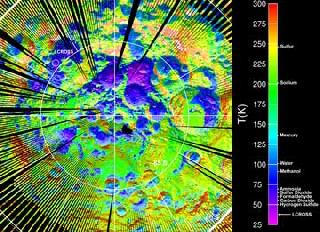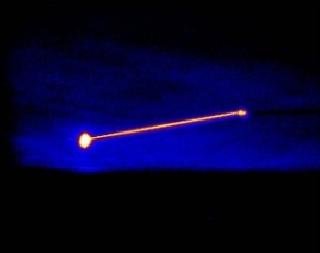
LRO Diviner Lunar Radiometer Experiment surface temperature map of the south polar region of the moon. Photo by UCLA/NASA/Jet Propulsion Laboratory, Pasadena, Calif./Goddard
WASHINGTON (PTI): A year after announcing the discovery of water molecules on the moon, NASA scientists have now said the earth's satellite is not only rich in useful materials, it has a water cycle of its own.
In fact, new studies suggest that there is a lot more water on the moon than earlier thought.
The new data uncovered by NASA's Lunar Crater Observation and Sensing Satellite, or LCROSS, and Lunar Reconnaissance Orbiter, or LRO found evidence that the lunar soil within shadowy craters is rich in useful materials, and the moon is chemically active and has a water cycle.
Scientists also confirmed the water was in the form of mostly pure ice crystals in some places. The results are featured in six papers published in the October 22 issue of Science.
"NASA has convincingly confirmed the presence of water ice and characterised its patchy distribution in permanently shadowed regions of the moon," said Michael Wargo, chief lunar scientist at NASA Headquarters in Washington.
The twin impacts of LCROSS and a companion rocket stage in the moon's Cabeus crater on October 9, 2009, lifted a plume of material that might not have seen direct sunlight for billions of years.
As the plume travelled nearly 10 miles above the rim of Cabeus, instruments aboard LCROSS and LRO made observations of the crater and debris and vapour clouds.
After the impacts, grains of mostly pure water ice were lofted into the sunlight in the vacuum of space, NASA said.
"Seeing mostly pure water ice grains in the plume means water ice was somehow delivered to the moon in the past, or chemical processes have been causing ice to accumulate in large quantities," said Anthony Colaprete, LCROSS project scientist and principal investigator at NASA's Ames Research Center in Moffett Field, California.
"Also, the diversity and abundance of certain materials called volatiles in the plume, suggest a variety of sources, like comets and asteroids, and an active water cycle within the lunar shadow," he said.
Volatiles are compounds that freeze and are trapped in the cold lunar craters and vapourise when warmed by the sun.
The existence of mostly pure water ice could mean future human explorers would not have to retrieve the water out of the soil in order to use it for valuable life support resources.
In addition, an abundant presence of hydrogen gas, ammonia and methane could be exploited to produce fuel, it said.
Scientists believe the water and mix of volatiles that were detected could be the remnants of a comet impact.
According to scientists, these volatile chemical by-products are also evidence of a cycle through which water ice reacts with lunar soil grains.
NASA said by understanding the processes and environments that determine where water ice will be, how water was delivered to the moon and its active water cycle, future mission planners might be better able to determine which locations will have easily-accessible water.
 Previous Article
Previous Article Next Article
Next Article













The Indian Air Force, in its flight trials evaluation report submitted before the Defence Ministry l..
view articleAn insight into the Medium Multi-Role Combat Aircraft competition...
view articleSky enthusiasts can now spot the International Space Station (ISS) commanded by Indian-American astr..
view article